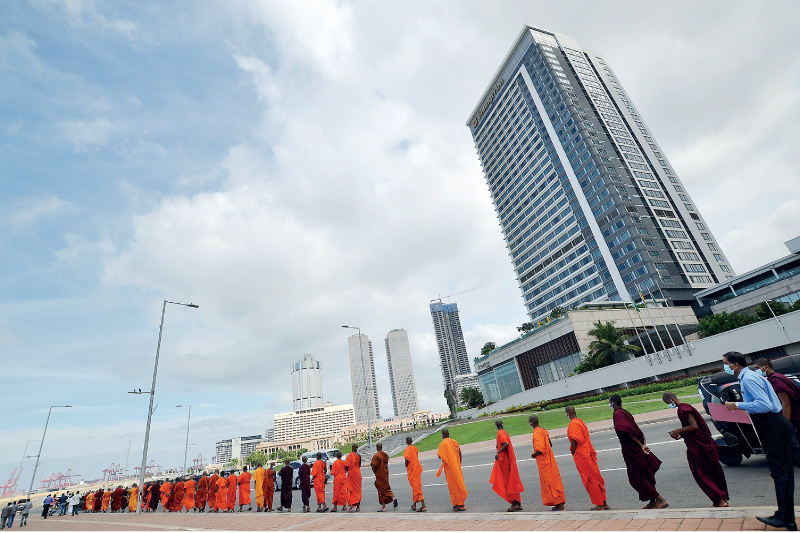Tuesday Apr 08, 2025
Tuesday Apr 08, 2025
Friday, 9 July 2021 00:07 - - {{hitsCtrl.values.hits}}

The dream planted in the minds of the Sinhala Buddhist people was that the journey towards the utopian state of Sinhala Buddhists will successfully reach its climax consequent to the victory of the 2019 Presidential Election and the 2020 Parliamentary Election. But, instead of the utopian state that they aspired to, they have finally got a dystopia, a failed state which is stinking, degenerated, corrupt and bankrupt – Pic by Shehan Gunasekara
 Any review of the issues which have been widely debated in Sri Lanka since the advent of the modern era followed by the emergence of a literate society will reveal that most of them have been detrimental to the national progress instead of producing benevolent results. The most debated topic in this context has been as to who the real owners of this country are.
Any review of the issues which have been widely debated in Sri Lanka since the advent of the modern era followed by the emergence of a literate society will reveal that most of them have been detrimental to the national progress instead of producing benevolent results. The most debated topic in this context has been as to who the real owners of this country are.
Usually a country under colonial rule tends to agitate first for securing religious reforms before attempting to win political reforms. Agitation for religious reforms and political reforms can be considered as two main stages in shaping the thinking of any country which was under colonial rule.
In general the experience in many countries which were under colonial rule was that the political potential created in the aftermath of agitations for religious revival had been complemented by subsequent agitations launched for political reforms. In fact, there was an obvious interrelationship between the two.
The Indian experience
There was a unique match between the independence movements with that of the religious revival in India which preceded the former, in terms of their ideology.
Rajram Mohan Roy and Syed Ahmed Khan were considered to be the two main leaders in the Hindu and Muslim revival movement respectively. But its religious revival movement was not limited to those two leaders only. Apart from them there were several other leaders involved in it.
The religious revival movement in India, taken as a whole, can be said to have had a very progressive vision. So much so, all of them, can be considered as religious leaders who did not assume that all the other religions except their own should be destroyed. On the contrary, they all accepted the need for religious tolerance and coexistence between different religions and endeavoured to bring the ideological framework of religions into a progressive phase in order to remove the outdated elements of religious norms and practices that led to persecute the people.
Thus, the ideology of the Religious Revival Movement in India harmonised well with that of its independence Movement. Both these movements were in accord that the feudal caste system should be abolished and the Indian nation should be built on a framework that ensures equal rights and human dignity to all people living in India without discrimination.
The situation in Sri Lanka
The behaviour of the religious revival movement in Sri Lanka assumed completely a different form. Particularly, the Sinhala-Buddhist revival movement launched by Anagarika Dharmapala was pursued as a campaign aimed at inciting hatred and anger against non-Buddhist religions and non-Sinhala communities.
According to Dharmapala, only Sinhala Buddhists can be considered as the “Bhumiputhras” or sons of the soil in Sri Lanka. All other ethnic groups such as Tamil, Muslim and Burgher were considered not as the natives of the land, but outsiders. Dharmapala branded those who consumed beef as Vasalayas or the people of lower castes.
Dharmapala can be considered as the thinker who had the strongest influence on the thinking of the Sinhala Buddhists people in Sri Lanka. He is held in high esteem as one of the foremost national heroes of Sri Lanka. His discordant and divisive pronouncements have been socialised with none to question their validity. Most of the anointed heroes of the temperance movement spearheaded by Dharmapala consisted of the children of arrack renters of Sri Lanka at the time.
The divisive views socialised by Dharmapala on Sri Lanka and its people affected not only the political leaders of Sri Lanka but also the Sinhala Buddhist people as well. He used to call all those living in this country who were not Sinhala Buddhists as pariahs or outcasts or someone who should be despised and avoided. Even the Sinhala Buddhists who did not belong to the Goyigama caste were regarded as low caste people with inferior birth. Dharmapala was a leader who tolerated caste discrimination in the Sinhala society.
Inviting troubles
The divisive ideology socialised by Dharmapala served as a significant factor in creating problems and conflicts in the country after independence.
The Burghers were the first community group perceived as pariahs during the early days of the country’s march towards independence. They were sarcastically and disparagingly referred to as the “Cockroach Lansies”. The Burghers, realising in advance that they had no future in an independent Sri Lanka, left the country in large numbers. Some of them who remained in Sri Lanka became victims of racism eventually.
By the time of the ’56 revolution, David Paynter, who could be considered as one of the greatest and internationally renowned artist produced by Sri Lanka, was the Principal of the Government Institute of Arts. The following is a slogan that appeared in a poster displayed against this reputed artist: “David the painter, go, get lost.”
D.S. Senanayake, the first Prime Minister of independent Sri Lanka, enacted citizenship laws in such a way that Indian plantation workers, who should have been entitled to citizenship, were deprived of those rights. Indian plantation workers won seven seats in Parliament in the 1947 General Election, but until the introduction of citizenship laws in 1977, they did not have a single seat in the Parliament.
Subsequently, in 1956, Bandaranaike enacted the Sinhala Official Languages Act, depriving the Tamils of their reasonable language rights. The consequences of this move for the country have been extremely devastating. Bandaranaike chose this path because it was the easiest way for him to come to power.
Three decades after independence, the country was plunged into a land of violent conflict and large-scale bloodshed which persisted for another three decades owing to the fact that the leaders who have come to power since independence have openly manipulated ethnic, caste and religious divisions to gain power instead of pursuing a policy to build the nation by spurning the recognition granted for ethnic, caste and religious differences. The horrific socio-political environment created has led to complete degeneration of the social and political system of the country that is rampant with corruption.
The dream of heralding a utopian state
Even after ending the internal Civil War, the policy of oppressing minorities was not abandoned. Instead the target of oppression was shifted from Tamils to Muslims. The Easter Sunday attack on Christian churches in April 2019 shocked and confounded the Sinhala-Buddhist psyche. Subsequently, the Sinhala-Buddhist electorate was able to win both the Presidential and Parliamentary election in 2019 and 2020 respectively, on their sole strength, and without the support of the minorities.
The dream planted in the minds of the Sinhala Buddhist people was that the journey towards the utopian state of Sinhala Buddhists will successfully reach its climax consequent to the victory of the 2019 Presidential Election and the 2020 Parliamentary Election. But, instead of the utopian state that they aspired to, they have finally got a dystopia, a failed state which is stinking, degenerated, corrupt and bankrupt.
Although the minorities have been persistently oppressed by the Sinhala racist rulers who came to power from time to time, in the final analysis, it is the Sinhala Buddhists who were most deceived by them.
Discover Kapruka, the leading online shopping platform in Sri Lanka, where you can conveniently send Gifts and Flowers to your loved ones for any event including Valentine ’s Day. Explore a wide range of popular Shopping Categories on Kapruka, including Toys, Groceries, Electronics, Birthday Cakes, Fruits, Chocolates, Flower Bouquets, Clothing, Watches, Lingerie, Gift Sets and Jewellery. Also if you’re interested in selling with Kapruka, Partner Central by Kapruka is the best solution to start with. Moreover, through Kapruka Global Shop, you can also enjoy the convenience of purchasing products from renowned platforms like Amazon and eBay and have them delivered to Sri Lanka.
Discover Kapruka, the leading online shopping platform in Sri Lanka, where you can conveniently send Gifts and Flowers to your loved ones for any event including Valentine ’s Day. Explore a wide range of popular Shopping Categories on Kapruka, including Toys, Groceries, Electronics, Birthday Cakes, Fruits, Chocolates, Flower Bouquets, Clothing, Watches, Lingerie, Gift Sets and Jewellery. Also if you’re interested in selling with Kapruka, Partner Central by Kapruka is the best solution to start with. Moreover, through Kapruka Global Shop, you can also enjoy the convenience of purchasing products from renowned platforms like Amazon and eBay and have them delivered to Sri Lanka.